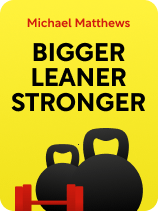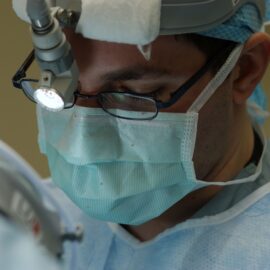

This article is an excerpt from the Shortform book guide to "Bigger Leaner Stronger" by Michael Matthews. Shortform has the world's best summaries and analyses of books you should be reading.
Like this article? Sign up for a free trial here.
Do you wish you could be bigger, leaner, and stronger? Are you motivated to get fit and just need a plan that works?
In Bigger Leaner Stronger, personal trainer Michael Matthews argues that you can get the physique you want. He presents science-based diet and exercise plans designed for men, and he provides a step-by-step guide to implementing them.
Continue reading for an overview of Bigger Leaner Stronger by Michael Matthews.
Overview of Bigger Leaner Stronger by Michael Matthews
In Bigger Leaner Stronger, Michael Matthews argues that the secret to achieving your dream physique isn’t a strict diet or a brutal workout. Instead, his simple, science-based approach to nutrition and exercise hinges upon two techniques: flexible dieting (a method of eating that helps you trim fat and build muscle without sacrificing the foods you love) and progressive tension overload (a workout approach that maximizes muscle growth). Follow his step-by-step guide, Matthews says, and you’ll learn, not only how to apply these techniques to your personal fitness goals and get healthy and fit fast, but also the science behind why they work.
Matthews is a certified personal trainer and the founder of Legion Athletics, a sports nutrition brand that provides supplements, meal plans, and coaching services. He’s written several other best-selling books, including Thinner Leaner Stronger, a fitness book for women, and The Shredded Chef, a cookbook for muscle-building and nutrition.
We’ll first discuss how you can set yourself up for success on your health and fitness journey by boosting your motivation and willpower. Then we’ll examine the science of weight loss and how you can create a flexible dieting meal plan. Finally, we’ll explore a workout plan based on progressive overload for maximum strength and muscle gains.
Part 1: Get Motivated For Your Fitness Journey
Transforming your health and physique takes commitment, and you must get in a good mindset first. Before we discuss Matthews’s methods for diet and exercise, let’s look at his ways to get motivated and strengthen your willpower.
Identify the Reasons for Your Fitness Journey
To stay motivated throughout your fitness journey, you must clarify the reasons you want to get stronger and healthier. Do you want to feel more confident or more energized? Do you want to enjoy more sports or get active with your family? Whatever your reasons are, Matthews suggests you write them down so you can always be reminded of them.
Next, imagine what your ideal physique looks and feels like. Find and save images of the body type you want. These images can serve as inspiration and remind you that your goals are real and achievable.
Boost Your Willpower
Now, you likely have some motivating reasons for getting stronger and healthier. However, immediate temptations, like craving your favorite junk food or skipping exercise to play video games, can still derail your fitness efforts if you’re not careful. To make long-lasting progress, you must strengthen your willpower and avoid temptations that can undermine your fitness efforts. Matthews gives some tips on how to deal with temptations when they arise:
Use the 10 minute rule. Wait 10 minutes to act on your cravings rather than try to suppress them. Suppressing cravings only makes them stronger. For example, if you’re itching to order fast food, accept that you have a craving, but force yourself to wait 10 minutes before making the order. Matthews argues that you’ll find that the temptation often becomes more manageable after 10 minutes simply because the urgency is gone.
Similarly, if you’re dreading a task (like exercising), force yourself to do it for at least 10 minutes. You’ll likely find it easier to continue once you’ve started.
Take precautionary measures. Matthews suggests you remove sources of temptation that might derail your fitness journey so it’s harder to give in. For example, leave your cell phone in a locker while at the gym so you don’t get distracted from your workout. This allows you to avoid testing your willpower altogether.
Avoid justifying bad decisions. Matthews writes that people often succumb to moral licensing, which is thinking you’ve earned the right to do something bad because you’ve done something good. For example, if you finish a strenuous workout, you might reason that it’s okay to “reward” your good behaviors with some junk food. To avoid moral licensing, Matthews recommends that you stop labeling your actions as good or bad and remind yourself of the reasons you want to get fit.
Part 2: Use Flexible Dieting to Build Muscle and Burn Fat
Now that you know how to prepare your mindset, let’s explore the role of nutrition in your health and fitness journey. Matthews argues that flexible dieting is the best nutrition approach to losing fat and building muscle. Flexible dieting simply means managing your calorie intake and eating a healthy balance of macronutrients (macros). This approach allows you to get the nutrients you need and the physique you want without sacrificing any particular foods.
Macros are nutrients that your body needs a large amount of to function properly—namely, proteins, carbohydrates, and fats. In the following sections, we’ll explain why flexible dieting works and discuss steps for creating your own meal plan based on this approach.
The Science Behind Weight Loss: Calories In, Calories Out
Matthews argues that, no matter what diet you follow, your weight depends on how many calories you eat and how many calories you burn. In other words, the amount of food you eat matters more than the kinds of foods you eat. This is because all foods give you energy (which is measured in calories), and, according to the law of thermodynamics, energy can’t be created or destroyed. Excess energy gets stored in your body as fat, so, to lose weight, you must simply eat fewer calories than you burn each day. When you expend more energy than you consume, your body burns fat.
Still, there are certain guidelines you should follow to maintain your health on this diet. According to Matthews, a flexible dieting meal plan should have three key elements:
Element #1: A large amount of protein. Protein helps your body build muscle and other tissues. According to Matthews, a high-protein diet can speed up fat loss, increase muscle gain, improve metabolism, decrease hunger, strengthen your bones, and boost your mood.
Element #2: Minimally processed foods. These are foods that are in a form very close to how they grow in nature (like vegetables, fruits, meats, and nuts), which contain many important nutrients your body needs. Matthews writes that the more foods get processed, the more likely they are to contain calories that don’t provide nutritional value. Minimally processed foods also help you burn more calories because they require more energy to digest. He says that ideally, 80% of your diet should consist of these types of food.
Element #3: Your preferred balance of carbs and fat. You can decide whether to eat more carbs versus more fat based on your taste. Matthews contends that the ratio of carbs to fat has little impact on your physique. If you’re relatively active, however, he says you should eat a moderate or high-carb diet to boost your muscle gain. Your body uses carbs to create glycogen, which fuels your workouts and helps you repair and build muscle.
How to Create Your Flexible Dieting Meal Plan
Now that you understand the science behind weight loss, let’s explore the steps of creating a meal plan for flexible dieting.
Step 1: Decide How You Want to Change Your Physique
Before you can create your meal plan, you must decide how you want to start changing your physique. You can prioritize losing fat, maintaining your current physique, or building muscle. Matthews explains that unless you’re new to strength training, you can’t effectively lose fat and build muscle at the same time: trimming fat requires reducing calories, and having fewer calories available hinders your body’s ability to build muscle. Getting stronger and leaner typically requires alternating between phases of losing fat and building muscle. Matthews suggests you decide what to focus on first based on your body fat percentage.
Let’s now look at the three ways to start changing your physique: cutting to lose fat, maintaining to stay at your current weight, or lean bulking to build muscle.
Option #1: Cutting—The purpose of cutting is to trim fat. This approach requires you to eat fewer calories than you burn. Matthews suggests you start with a cutting phase if your body fat percentage is over 15%. Higher body fat takes longer to cut, requiring you to resist cravings longer, so working to reduce your body fat first makes it easier to succeed in subsequent cuts. End your cutting phases at around 10% to 12% body fat, as it’s harder to get leaner without intense diet control and exercise.
Option #2: Maintaining—The purpose of maintaining is to stay at your current weight and slowly build muscle. To do this, you must eat the same amount of calories you burn. According to Matthews, you should maintain if you’re happy with your physique.
Option #3: Lean Bulking—The purpose of lean bulking is to build muscle and strength. This phase requires you to eat more calories than you burn. While this optimizes muscle-building, you’ll also gain some fat in the process. Matthews suggests you end your lean bulk when you have around 15% to 17% body fat so you don’t gain too much fat you’ll need to cut later.
Step 2: Calculate Your Daily Calorie Target
Once you know if you want to cut, maintain, or lean bulk and whether to add or subtract calories from your diet, you must figure out the right amount of calories to eat daily. Consider three factors when calculating your target calories: your body recomposition goal, how active you are, and your weight.
Matthews suggests different ranges of calories to target when cutting, maintaining, and gaining. You should aim for the higher or lower end of this range depending on how active you are. If you’re less active, aim for the lower end. If you’re very active, aim for the higher end.
- If you’re cutting: Consume eight to 12 calories per pound of body weight daily. For most, this creates the 20 to 25% calorie deficit necessary to lose weight.
- If you’re maintaining: Consume 12 to 16 calories per pound of body weight daily.
- If you’re lean bulking: Consume 16 to 18 calories per pound of body weight daily. This typically creates the 10% calorie surplus needed for building muscle without gaining too much fat.
Step 3: Calculate Your Target Calories for Each Macronutrient
Once you know how many calories you should eat in a day, calculate how many calories you need to allot to each macronutrient (protein, carbs, and fat). The percentages that Matthews recommends are:
- Protein should make up around 30% to 40% of your daily calories. One gram of protein has about four calories.
- Carbs should make up around 30% to 50% of your daily calories. One gram of carbs has about four calories.
- Fats should make up around 20% to 30% of your daily calories. One gram of fat has about nine calories.
These percentages don’t need to add up to 100%—leave up to 20% free for treats (we’ll discuss how to add these to your diet later). To calculate your target calories for each macro, multiply your total daily target by the appropriate percentage in decimal form. For example, 2400 (total daily calorie target) x 0.3 (protein calorie target) is 720 calories of protein daily (or 180 grams).
Step 4: Plan Your Meal Schedule and What Foods to Eat
Once you’ve calculated your target calories, you can start planning your meals accordingly. While flexible dieting gives you the freedom to choose foods that you like, Matthews suggests you eat several portions of vegetables and fruits and get most of your calories from vegetables, fruits, whole grains, healthy fats, legumes, and tubers. When selecting proteins, Matthews recommends proteins from animal rather than plant sources because animal proteins tend to be better for building muscle.
First, decide how many meals to eat each day and when so you can plan out portions that meet your daily targets. For the most part, this should depend on your appetite, schedule, and overall preference. Matthews writes that most people eat four to six meals a day (including snacks) and suggests you eat at least two to improve your body’s ability to build muscle.
Next, create a list of your favorite proteins, carbohydrates, and fats (that are, ideally, nutritious and minimally processed) and write down some of your favorite treats. Include any drinks that contain calories. Matthews recommends you get no more than 10% of your daily calories from these drinks because they’re typically less nutritious and filling than foods.
Step 5: Create Your Meals
Now, you can use your daily calorie target, your macro calorie targets, and the list of foods you like to create your meal plan. To calculate how many calories a certain food or meal has, Matthews suggests you use online resources and find simple recipes that provide sufficient nutritional information for you to make your calculations.
Focus on one macronutrient at a time to make calculations easier. Each time you add a food to your daily meal plan, subtract its calories from your daily macro target. Add foods until you meet about 80% of each macronutrient target. Many foods overlap in carbs, fats, and proteins, which will make up for the rest of the calories needed for each target.
Matthews recommends you build your meal plan in this order:
1. Add your proteins. Try to eat protein three times a day because it helps build muscle and manage hunger. Matthews suggests you eat at most 30 to 40 grams of protein per meal because there’s a limit on how much muscle your body can build from protein consumed in a single serving.
2. Add your carbohydrates. To ensure you get your nutrients in, Matthews suggests you add at least three portions of vegetables and then move on to other nutritious carbs like fruits and whole grains.
3. Add your fats. Matthews suggests you focus on foods containing mostly unsaturated fats, such as nuts, dairy, meats, and eggs.
4. Add your treats. These can be anything from your favorite sweets to drinks, including alcohol. Treats should make up the remaining calories after you subtract proteins, carbs, and fats from your total target calories. Matthews writes that you can allot up to 20% of your daily calories to treats.
According to Matthews, it’s occasionally acceptable to stray from your meal plan and have “cheat meals” or “cheat days” where you don’t worry about calories or macros. However, be sure to limit these to no more than two a week. Also, he advises you to avoid eating out at restaurants more than once a week when cutting and more than twice a week when maintaining or lean bulking. It’s often harder to estimate the calories and macros in meals you don’t prepare.
Additional Nutrition Tips
Now that you know how to create a meal plan for flexible dieting, let’s consider some additional nutrition tips from Matthews for maximizing muscle gain and fat loss.
Eat Protein Before or After Your Workout
Matthews recommends you eat 30 to 40 grams of protein either within three to four hours before your workout or within an hour after. Eating protein before a workout provides your body with the necessary nutrients for muscle growth and helps start its muscle-building process. As your workout progresses, your body begins to break down muscle proteins at a higher rate. Eating protein after your workout ensures your body builds more muscle than it breaks down.
Supplements Help but Aren’t Necessary
According to Matthews, you don’t need to take supplements to achieve your ideal physique. However, there are four supplements that can make it easier to get the nutrients you need.
Protein Powder: Powdered forms of protein (such as whey or casein) can help you to meet your daily protein goal. However, limit protein powder to less than half of your daily protein, as too much can cause gastrointestinal problems, and protein-rich foods tend to be more nutritious and filling.
Fish Oil: Omega-3 is an essential fatty acid found in fatty fish, flaxseed, and walnuts, with many health benefits such as reducing inflammation. Consuming sufficient amounts can be hard to do with food alone.
Creatine: A substance made of amino acids that your body naturally produces small amounts of. Creatine can improve muscle growth and recovery.
Part 3: Use Progressive Overload to Maximize Strength Gains
Now that you know how to diet to lose fat, build muscle, and improve your nutrition, let’s look at ways to exercise effectively to get strong fast.
The Science Behind Effective Exercise: Progressive Tension Overload
To maximize strength and muscle gain, you must use a technique called progressive tension overload, which means that you apply an increasing amount of stress to your body by incrementally using heavier weights. This method forces your body to adapt and bear heavier loads, which boosts your muscle gains, writes Matthews.
Progressive overload creates more mechanical tension, which is the most important driver of muscle growth. Mechanical tension is the force created when you increase the stress on your muscles (such as with weights) while they stretch or contract. The heavier the weight, the more stress you put on your muscles, which results in greater mechanical tension. Because of this, you build more muscle by lifting heavier weights for fewer repetitions than by lifting lighter weights for more repetitions. We’ll look at how to apply progressive overload to your workouts in more detail in the following sections.
How to Create Your Strength Training Workout Plan
Now that you understand the science behind weight loss and muscle gain, let’s look at some of Matthews’s tips for creating your strength training plan.
Step 1: Create Your Weekly Schedule
According to Matthews, you should strength train three to five times per week. This arrangement allows you to recover adequately and avoid overtraining. Your muscles grow stronger during rest, not during your workout.
Step 2: Choose Your Exercises
Once you’ve determined which days you plan to work out, you must decide what exercises to do. Matthews recommends you do exercises that target the muscles involved in pushing, pulling, and squatting, which ensures you train all of your major muscle groups.
Matthews says there are two types of exercises you should use in your workouts: primary exercises and accessory exercises. Primary exercises train multiple muscle groups at a time and drive the majority of your muscle growth. However, since they don’t work all muscles adequately, you must also do accessory exercises, which are usually isolation exercises that focus on one specific muscle group. Some examples of primary exercises are pull-ups (pulling), dips (pushing), and barbell squats (squatting). Examples of accessory exercises include dumbbell curls (pulling), seated triceps presses (pushing), and dumbbell lunges (squatting).
Step 3: Use Double Progression for Effective Workouts
Now that you have your weekly schedule and exercises planned, how many reps and sets should you do during your workouts? A repetition (or “rep”) is a single movement (like one pull-up). A set is a group of reps you do in succession (like 10 pull-ups).
According to Matthews, you need to do nine to 12 hard sets for each major muscle group per week for optimal gains. He recommends doing nine to 12 hard sets per session (with each session focusing on one muscle group) to achieve this. For example, you might do three sets of four different pushing exercises in one workout. He suggests this because there’s an upper limit to the number of sets you can do to maximize muscle growth per workout.
Determine what a “hard set” is for you by using a method called double progression, which is a way of applying progressive tension overload. Double progression requires you to do exercises within a range of reps to determine when to add more weight to your exercise. If you reach the upper limit of your repetition range, you add 10 pounds.
- For primary exercises, your range should be four to six reps.
- For accessory exercises, your range should be six to eight reps.
For instance, if you can reach the upper limit of your primary exercise rep range (six), add 10 pounds. Then, continue doing sets in your rep range until you can hit the upper limit again using the heavier weight. If you can’t reach the minimum of the rep range (four) with the heavier weight, reduce the weight by five pounds and try again. If you still can’t reach the minimum, work with your original weight until you can complete the upper limit of reps for two to three sets.
Step 4: Prevent Injury During Your Workouts
To prevent injury while optimizing strength gain, Matthews provides several tips:
Tip #1: Warm up by doing easier reps of the exercises you plan to do—for example, by using lighter weights. This prepares your muscles and helps you get into proper form.
Tip #2: Finish most of your hard sets close to but not at muscle failure, the point at which you can’t physically complete another rep. Stop while you’re still able to do one to three good sets to prevent injury.
Tip #3: Rest for two to four minutes between sets. This gives your muscles enough time to recover and perform better during your workouts.
Step 5: Plan for a Deloading Phase
After eight weeks of training, Matthews suggests you take a deload—or reduce the volume or intensity of your workouts for a week—to give your body time to recover and grow stronger. It’s better to reduce volume (in other words, do fewer sets and reps) than reduce intensity (use lighter weights), Matthews argues. Deloading volume lessens joint, tendon, and ligament strain, lowers the risk of injury, and reduces psychological stress. It also maintains your fitness better when you resume training.

———End of Preview———
Like what you just read? Read the rest of the world's best book summary and analysis of Michael Matthews's "Bigger Leaner Stronger" at Shortform.
Here's what you'll find in our full Bigger Leaner Stronger summary:
- How to get the physique you want without trendy diets or brutal workouts
- A simple and scientific approach to nutrition and exercise
- How to plan a workout program based on progressive overload






